OR/14/043 Site description - Cors Erddreiniog
| Farr, G, Graham, J, and Stratford, C. 2014. Survey, characterisation and condition assessment of Palustriella dominated springs 'H7220 Petrifying springs with tufa formation (Cratoneurion)' in Wales. British Geological Survey Internal Report, OR/14/043. |
Introduction
Cors Erddreiniog (SSSI, SAC and NNR) has been subject to numerous ecological and hydrological investigations (e.g. Gillman and Newson, 1981, SWS, 2010[1], Rigare, 2010[2]) and as such there is a comparative wealth of information on both the ecology and hydrology of Cors Erddreiniog. Monitoring of both groundwater quality and groundwater levels has been in place since 2006 and 2008 respectively. This survey included the area along the eastern margin of Cors Erddreiniog, south of the Cae Gwyn restoration project and immediately east of the lake Llyn-yr-Wyth Eidion.
Geological and hydrogeological data
The boundary between the Carboniferous Clwyd Limestone Group and underlying Lligwy Sandstone runs parallel to the boundary of the site and it is most likely that discharge from these units is the principal groundwater feed responsible for the historic and current marl deposits. Piezometers drilled along this margin (e.g. ED4, ED4a) prove up to 2.5 m of clays, sands and marl overlying weathered limestone within a clay matrix. Groundwater discharges from the Carboniferous Limestone aquifer via discrete springs and large seepage areas occur across the eastern boundary of Cors Erddreiniog. Previous analysis in 2008 (BGS) of CFCs and SF6 at the ‘spring north of Hazelwood’ (Site CE2.2) suggested an age for the water between 1975–2006 indicating that there is both an older and younger component to the groundwater along this margin of Cors Erddreiniog.
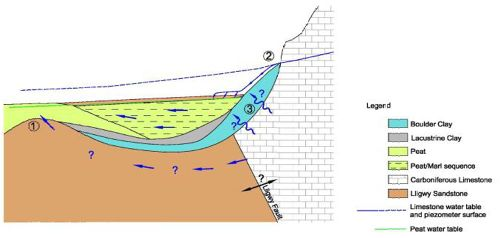
During the survey two full samples were collected (Sites CE3.3–A and CE5.3–B) and two nutrient only samples (Sites CE1.1 and 2.1). pH values ranged from 7.14–8.14 and the dominant ions are calcium and bicarbonate. During this survey phosphate, orthophosphate and nitrite were all below their respective limits of detection (<0.02 mg/l, <0.02 mg/l and <0.004 mg/l). Nitrate N mg/l occurred in all four samples and ranged from 1.93–7.35 mg/l N. Groundwater monitoring between 2006–2013 (see Figure 91) has shown a gradual decrease in the levels of Nitrate-N mg/l. Phosphate (P) mg/l has returned values below the limit of detection for the majority of the monitoring period. This is the only site within the survey that has the benefit of associated groundwater chemistry data from a pre existing monitoring network.

Land use and pressures
The survey site is located on the far eastern boundary of the Cors Erddreiniog SAC boundary and all the land within this is managed by NRW. However the land directly to the east of the boundary is managed for agricultural purposes. The survey site benefits with being located far from the nearest footpath and thus footfall at the site is very low. There is limited evidence of poaching along the break in slope most likely from grazing animals managed by NRW at Cors Erddreiniog. There is no evidence of burning. There are several historic private water supplies (wells and springs) along this margin however none are currently in use.
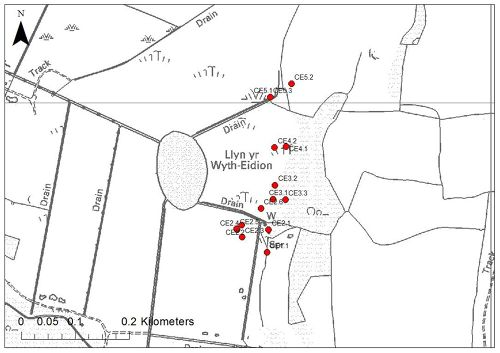
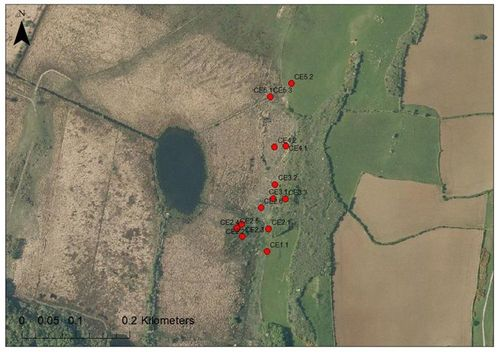
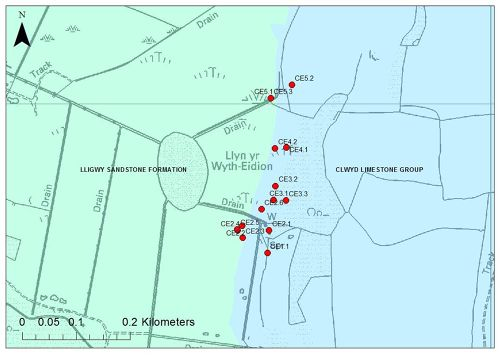
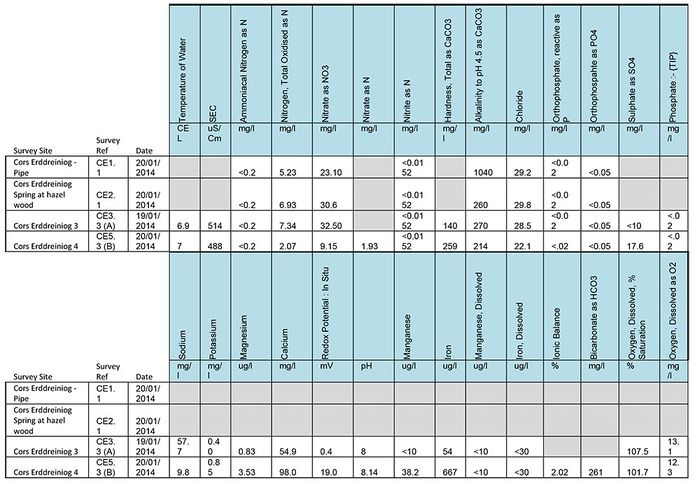
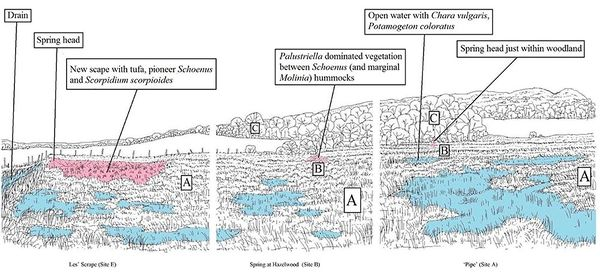
Vegetation (spring) for Cors Erdderiniog
Six samples (A–F) were taken from along the margin of a single site (Cors Erdderiniog), a lowland calcareous fen. Four samples (B–D) had good stands of Palustriella commutata while a single sample (F) had only a single patch of Palustrtiella commutata representing a pioneer within a area recently scraped as part of conservation management. The 4 main sites (B–D) are associated with springs and seepages flowing onto the fen from the east down a gentle slope parallel to the woodland. The spring heads have dominant patches of Palustriella commutata with Conocephalum salebrosum (especially where rocky or wooded) and the Palustriella vegetation then continues along the margins of the spring runnels before quickly being replaced by Camplylium stellatum, Bryum psedotriquetrum and then a rapid transition into tall fen vegetation (dominated by Juncus species) or open water communities. The Palustriella commutata dominated vegetation is associated with Campylium stellatum, Fissidens adianthoides, Cratoneuron filicinum, Ctenidium molluscum, Scorpidium cossonii and locally Scorpidium scorpioides, Philonotis calcarea. Palustriella commutata dominated vegetation often grows at ground level between tussocks of Schoenus nigricans.
| Species | A | B | C | D | E | F |
| Palustriella commutata | A | A | A | A | R(<1%) | |
| Schoenus nigricans | F | F | F | |||
| Pellia endiviifolia | O | O | R | O | ||
| Carex flacca | O | O | O | O | R(<1%) | |
| Anagallis tenella | O | O | O | O | O | |
| Juncus acutiflorus | O | O | O | F | A | |
| Fissidens adianthoides (spor.) | O | R | O | R | ||
| Anera pinguis | O | R | R | R | ||
| Chara vulgaris | R | O | ||||
| Bellis perennis | R | R | O | |||
| Cratoneuron filicinum | F | R | O | |||
| Scorpidium cosonni | O | R(<1%) | ||||
| Camplylium stellatum | O | R(<1%) | ||||
| filamentous algae (Chlorophyta) | O | R | R | R | ||
| Brachythecium rivulare | R(<1%) | |||||
| Calliergonella cupidata | R | R | R | |||
| Carex demmisa | R | R | R | |||
| Centaurea nigra | R(<1%) | |||||
| Cirsium palustre | R | R | R | R | ||
| Conocephalum salebrosum | O | |||||
| Ctenidium molluscum | R | R | ||||
| Festuca rubra | R | R(<1%) | R(<1%) | R(<1%) | ||
| Epilobium sp. | R | R | ||||
| Holcus lanatus | R(<1%) | |||||
| Juncus effusus | R | |||||
| Juncus inflexus | R(<1%) | R(<1%) | ||||
| Agrostis stolonifera | R(<1%) | R(<1%) | ||||
| Philonotis calcarea | R | |||||
| Plantago lanceolata | R(<1%) | R(<1%) | R(<1%) | R(<1%) | ||
| Trifolium repens | R(<1%) | |||||
| Senecio cf aquaticus | R | |||||
| Scorpidium scorpioides | R | |||||
| Succisa pratensis | R | |||||
| Triglochin palustre | R |
Molinia and Schoenus tussocks, many of which are old and partly decaying that provided a habitat for bryophytes and flowering plants above the level of regular seepage water (i.e receiving rain water) A broad number of typically califuge species occur including Potentilla erecta, Erica tetralix, Succisa and tiny plants of Pteridium. However, the presence of some generally calcicole species (such as Ctenidium molluscum, Eurhychium striatum) suggests that these tussocks may be able to draw base-rich water above the level of seepage.
| Species | A | B | C | D | E | F |
| Molinia caerulea | O | F | O | O | R | |
| Schoenus nigricans | F | O | O | |||
| Ctenidium molluscum | O | A | O | |||
| Thuidium tamariscinum | O | O | ||||
| Eurhynchium striatum | R | O | ||||
| Potentilla erecta | O | R | R | R | ||
| Anera pinguis | R | R | ||||
| Brachythecium rivulare | R | |||||
| cf Pedicularis palustris | R | |||||
| Campylium protensum | R | |||||
| Centaurea nigra | R | |||||
| Cratoneuron filicinum | R | |||||
| Erica tetralix | R | R | R | |||
| Filipendula ulmaria | R | |||||
| Ctenidium molluscum | R | |||||
| Lotus cf pedunculatus | R(<1%) | R(<1%) | ||||
| Plagiomnium elatum | R | |||||
| Polygala serpyllifolia | R | R | ||||
| Primula sp. | R | |||||
| Pteridium aquilinum | R(<1%) | |||||
| Rubus fruticosus | R(<1%) | |||||
| Scleropdium purum | R | R | ||||
| Succisa pratensis | R | R | R |
Vegetation adjoining spring for Cors Erdderiniog
Low growing bryophyte dominated vegetation (without Palustriella) and Campylium stellatum, Bryum psuedotriquetrum, Fissidens adianthoides, Cratoneuron filicinum, Calliergonella cuspidata.
| Species | A | B | C | D | E | F |
| Camplylium stellatum | F | A | ||||
| Calliergonella cupidata | O | A | ||||
| Anagallis tenella | O | O | ||||
| Bryum pseudotriquetrum | R | O | O | |||
| filamentous algae (Chlorophyta) | O | |||||
| Fissidens adianthoides | O | |||||
| Cratoneuron filicinum | O | |||||
| Pellia endiviifolia | O | |||||
| Prunella vulgaris | O | |||||
| Juncus acutiflorus | O | |||||
| Anera pinguis | R | R | R | |||
| Agrostis stolonifera | R(<1%) | |||||
| Carex demmisa | R | |||||
| Carex flacca | F | |||||
| cf Oenanthe sp. | R | |||||
| Cirsium palustre | R | |||||
| Ctenidium molluscum | R | |||||
| Epilobium sp. | R | |||||
| Festuca rubra | R(<1%) | |||||
| Juncus effusus | F | |||||
| Juncus inflexus | R | |||||
| Mentha aquatica | R(<1%) | |||||
| Ranuculus cf acris | R(<1%) | |||||
| Ranunculus flammula | R | |||||
| Taraxacum sp. | R(<1%) | |||||
| Equisetum palustre | R |
Open water communities dominated by flowering plants with a preference for calcareous water including Chara vulgaris, Potamogeton coloratus.
| Species | A | B | C | D | E | F |
| Chara vulgaris | O | F | O | O | R | |
| Calliergonella cupidata | F | O | O | |||
| filamentous algae (Chlorophyta) | O | A | O | |||
| Juncus subnodulosus | O | O | ||||
| Nasturtium officinale s.l. | R | O | ||||
| Potamogeton coloratus | O | R | R | R | ||
| Ranunculus flammula | R | R | ||||
| Veronica beccabunga | R | |||||
| Typha latifolia | R | |||||
| Agrostis stolonifera | R | |||||
| Apium nodiflorum | R | R | ||||
| Angelica sylvestris | R | |||||
| Epilobium sp. | R | R | R | |||
| Equisetum fluviatile | R | |||||
| Galium palustre ssp. palustre | R | |||||
| Glyceria fluitans | R(<1%) | R(<1%) | ||||
| Hypericum tetrapterum | R | |||||
| Mentha aquatica | R | R | ||||
| Ranunculus repens | R | |||||
| R(<1%) | ||||||
| R(<1%) | ||||||
| R | R | |||||
| R | R | R |
Tall calcareous fen community dominated by Juncus species and occasional Cladium mariscus.
| Species | A | B | C | D | E | F |
| Juncus acutiflorus | R | A | F | F | ||
| Juncus effusus | F | F | ||||
| Juncus inflexus | O | F | F | |||
| Triglochin palustre | R | F | ||||
| Cladium mariscus | O | O | ||||
| Juncus subnodulosus | O | R | ||||
| Molinia caerulea | O | |||||
| filamentous algae (Chlorophyta) | R | |||||
| Filipendula ulmaria | R | O | ||||
| Hypericum tetrapterum | R | R | ||||
| Calliergonella cupidata | R | |||||
| Nasturtium officinale s.l. | R | |||||
| Senecio cf aquaticus | R |
Scrub Woodland (Blackthorn & Hazel) occurs on the eastern margin of Cors Erdderiniog and surrounded a spring head in one sample point (B). The ground flora was dominated by Bramble with a few other species (Primula vulgaris, Hedera, Brachypodium sylvaticum) and scattered Bracken.
| Species | A | B | C | D | E | F |
| Prunus spinosa | F | |||||
| Hedera helix | O | |||||
| Rubus fruticosus agg. | O | |||||
| Betula cf pubescens | R | |||||
| Brachypodium sylvaticum | R | |||||
| Corylus avellana | R | |||||
| Fissidena taxifolius var. taxifolius | R | |||||
| Primula vulgaris | R | |||||
| Pteridium aquilinum | R |
Condition assessment
The overall assessment is that Cors Erdderiniog (Sites A–F) as being in favourable ecological and hydrogeological condition.
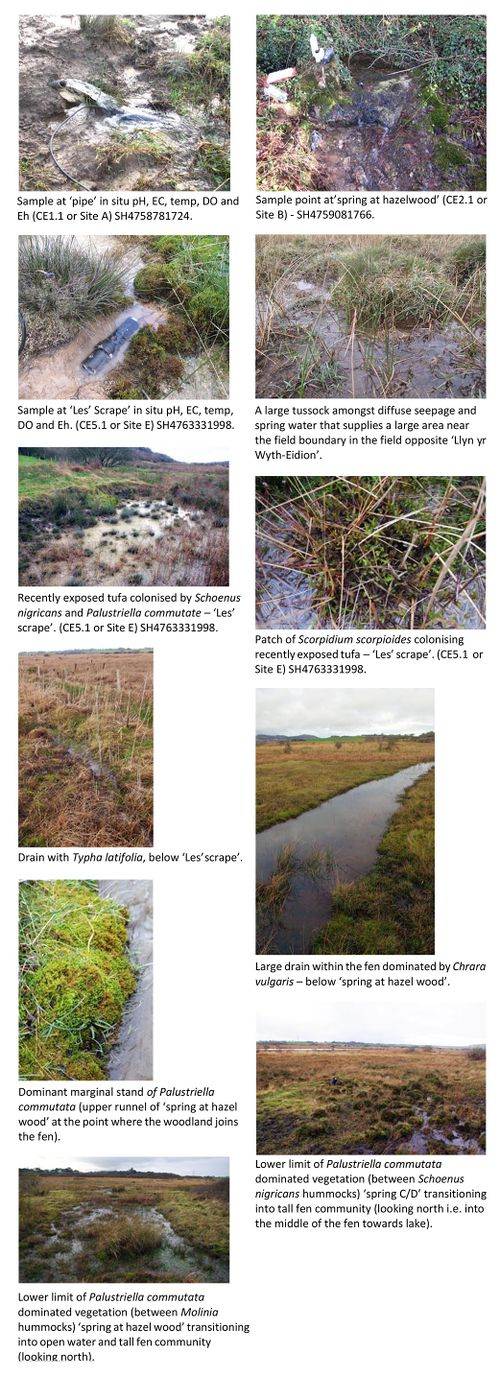
References
- ↑ SWS. 2010. Desk study Cors Erddreiniog investigations on selected Welsh groundwater dependent terrestrial ecosystems (GWDTEs). For Environment Agency, November 2010. 1–274/R3 Final.
- ↑ 2.0 2.1 RIGARE. 2010. Technical investigations to inform large scale terrain re-profiling at Cors Erddreiniog, NNR Anglesey Fens SAC. For Countryside Council for Wales, 1458_r1.